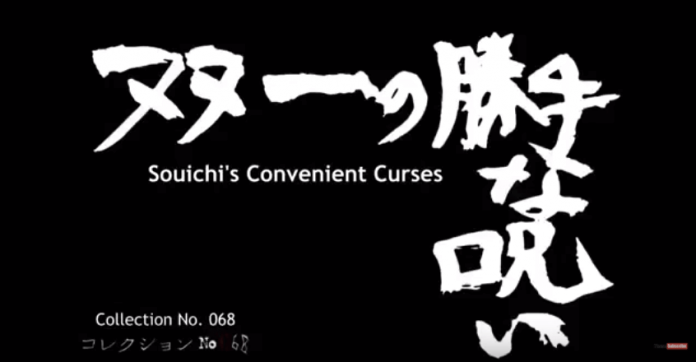Having recently become a fan of Junji Ito and having been a long-time fan of Lovecraftian Horror as a genre, it is only natural I would be excited for Studio DEEN’s “Junji Ito Collection,” an anthology series whose first episode aired yesterday.
* Disclaimer: the review below will be spoiler free. The author has not read the original “Souichi’s Convenient Curse” due to a lack of official translation.

The first of many beautiful shots this series has to offer.
The series made an absolutely amazing first impression with its beautiful backgrounds and muted colour palette, both of which create a foreboding atmosphere while building on Ito’s strengths and weaknesses. Unfortunately, some might see these things as “samey” while the episode goes on.
More importantly, though, the overall quality decreases when characters are on-screen. “Souichi’s Bare-bones Backgrounds” lives up to that sarcastic rename, as things regularly become more simplistic to draw focus to the characters, who are mostly indistinct – techniques Ito himself regularly employs. Unfortunately, this simplicity makes the viewer notice how “off-model” the characters are from time to time – especially when the differences between them are superficial and overt.

Even this anime cannot escape the “Yandere pose of ecstasy.”
But how do these characters look when in motion? Simply put, a more accurate title for the episode is “Souichi’s Abhorrent Animation,” as characters’ bodies move well enough – but their mouth movements and certain close-ups draw attention to their uncanny designs in all the wrong ways. Instead of seeming horrific, they come across as unintentionally hilarious – especially Souichi’s psychotic smirk [pictured above].
Having never read “Souichi’s Triumphant Translation,” I genuinely cannot tell what was intentional and what wasn’t. Is this supposed to be a parody, or did it just end up as one? To elaborate…
This episode was tonally inconsistent at best. In many scenes, it does an excellent job at creating a foreboding atmosphere – but in the next, that tension is broken up by comedy that is neither interesting nor funny. When the episode does something right, it undercuts its success; for example, that one of the last scenes has a positively excellent and somewhat horrific 30 seconds [complete with stunning visuals and SFX], only to awkwardly and abruptly return to half-hearted parody.

How I felt about the tonal inconsistencies.
In a unique turn from Ito’s usual work, “Souichi’s Centralized Character” focuses on Souichi himself rather than his hapless victims. In addition, while the central character is cartoonishly evil, his interactions with others [and especially his family] ground him and even make the parody stand out. He is just a kid, after all – if a very misguided and eccentric one – so it’s only natural the stakes would be low and people would find him bizarre!
The sound design is easily where this episode shines. As manga is a purely visual medium, Studio Deen had an opportunity to highlight the horror through sound – and they didn’t disappoint. Even as tonally bizarre as it is, “Souchi’s Auditory Amazement” regularly highlights its atmosphere through ambient music – but it also knows how valuable silence can be in key scenes. Sound effects, meanwhile, are used to an almost “punchy” effect and never feel out of place or overblown.
Frankly, the only issue is with the voice acting. As a non-Japanese speaker, I believe the characters come across as naturally as they can; however, Souichi’s high-pitched voice can come across as grating from time to time.
Frankly, I am left with a number of questions after having watched this episode. Chief among them is “why start with this and not something else?” Junji Ito has many popular and iconic stories – stories that do a better job of introducing wider audiences to his style. This bizarre mix of horror and comedy [whether intentional or not], might serve to turn some people off from the series before it has even started!
Secondly, the episode raises an interesting conversation about what is authorial intent and what is a mistake. Is it better to be a faithful adaptation, even if it means copying issues from the source material – especially when those issues are mostly visual and easily corrected? Personally, I don’t think so, but it’s something to keep in mind throughout the rest of the series.
Thirdly and finally, can Junji Ito be faithfully adapted at all? While it’s still too early to tell, I feel that Studio Deen has their work cut out for them; Junji Ito’s manga regularly terrifies the reader by making them turn a page at an inopportune moment, whereas an anime is unaffected by layouts and paneling…
Regardless, I feel mixed on this episode at best, and I’m certain many viewers will feel the same. The next episode preview certainly looks promising – and because it is an anthology, the series has an almost limitless amount of potential.
Animation: 4/10
Writing: 4/10
Sound: 8/10
Overall: 5/10



